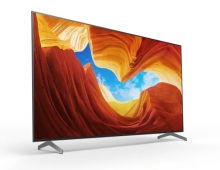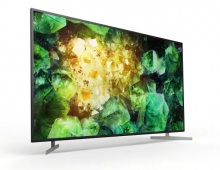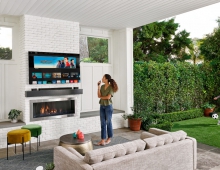
UHD TV Panels to be New Focus Area for LCD Panel Makers
Shipments of ultra-high-definition (UHD) television panels are poised to reach
2.3 million units this year as they make their first-ever appearance on the
market, fueling what panel makers hope will be a new source of profitability,
according to information and analytics provider IHS.
Featuring a resolution four times that of standard 1080p high-definition sets,
UHD displays are set to become the star offering from the makers of liquid-
crystal display (LCD) panels. The projected shipments this year are up from a
virtually nonexistent base in 2012, and growth in the years ahead will be at
galloping three-digit and high-double-digit rates. By 2017, UHD panel shipments
are forecast to reach 20.8 million units.
LCD panel makers are extremely bullish about UHD displays for several reasons. Saddled by low average selling prices in the wake of a maturing global TV market, LCD makers hope that UHD panels will become the premium product they need to spur replacement demand for televisions among consumers. And as a high- end product, UHD will be able to better compete with organic light-emitting diode (OLED), also an advanced display technology with superior image quality that was making inroads until the production ramp-up got delayed by manufacturing problems.
Panel makers point out other encouraging factors that they say will help UHD succeed in the market?unlike 3-D, which held out enormous promise at the beginning but was eventually overcome by both technological and marketing hurdles. In contrast to 3-D where material was difficult to come by, UHD could be featuring native content by next year, and UHD panels also will be able to upscale broadcasts made in standard high-definition. Moreover, upscaling technology is being built into new peripherals like DVD players, game consoles, cameras and camcorders - a broader range of accessories supporting the new technology than 3-D was ever able to achieve.
Still, there are issues that LCD suppliers will need to resolve where UHD manufacturing is concerned. For instance, not enough production capacity exists in the latest-generation LCD fabrication plants known as Gen 10, which is already being used to produce super-large-sized panels like the 60- and the 70- inch. Meanwhile, the Gen 8.5 production lines responsible for various TV panels, such as the 32-, 46- and 55-inch,, deprive the lines of otherwise dedicated capacity for UHD panels.
The price of UHD televisions will also have come down to a point within reach of consumers for panel suppliers to make them. The 55-inch UHD set from Sony currently carries a retail price of $5,000, while the 65-inch model is even more expensive at $7,000. In comparison, a 55-inch LED-backlit LCD TV from Samsung Electronics can be had for just $900. To build demand for their panels, LCD suppliers are aggressively reducing the price of UHD displays, lowering them to just 1.1 or 1.2 times the price of 1080p full high-definition panels.
The UHD panels being shipped this year will be in a wide range of sizes, including very large measurements from 84- to 110-inches. Most panel suppliers, including the Chinese, are either already mass-producing UHD panels or have plans to introduce them in the second half of this year.
LCD panel makers are extremely bullish about UHD displays for several reasons. Saddled by low average selling prices in the wake of a maturing global TV market, LCD makers hope that UHD panels will become the premium product they need to spur replacement demand for televisions among consumers. And as a high- end product, UHD will be able to better compete with organic light-emitting diode (OLED), also an advanced display technology with superior image quality that was making inroads until the production ramp-up got delayed by manufacturing problems.
Panel makers point out other encouraging factors that they say will help UHD succeed in the market?unlike 3-D, which held out enormous promise at the beginning but was eventually overcome by both technological and marketing hurdles. In contrast to 3-D where material was difficult to come by, UHD could be featuring native content by next year, and UHD panels also will be able to upscale broadcasts made in standard high-definition. Moreover, upscaling technology is being built into new peripherals like DVD players, game consoles, cameras and camcorders - a broader range of accessories supporting the new technology than 3-D was ever able to achieve.
Still, there are issues that LCD suppliers will need to resolve where UHD manufacturing is concerned. For instance, not enough production capacity exists in the latest-generation LCD fabrication plants known as Gen 10, which is already being used to produce super-large-sized panels like the 60- and the 70- inch. Meanwhile, the Gen 8.5 production lines responsible for various TV panels, such as the 32-, 46- and 55-inch,, deprive the lines of otherwise dedicated capacity for UHD panels.
The price of UHD televisions will also have come down to a point within reach of consumers for panel suppliers to make them. The 55-inch UHD set from Sony currently carries a retail price of $5,000, while the 65-inch model is even more expensive at $7,000. In comparison, a 55-inch LED-backlit LCD TV from Samsung Electronics can be had for just $900. To build demand for their panels, LCD suppliers are aggressively reducing the price of UHD displays, lowering them to just 1.1 or 1.2 times the price of 1080p full high-definition panels.
The UHD panels being shipped this year will be in a wide range of sizes, including very large measurements from 84- to 110-inches. Most panel suppliers, including the Chinese, are either already mass-producing UHD panels or have plans to introduce them in the second half of this year.





















